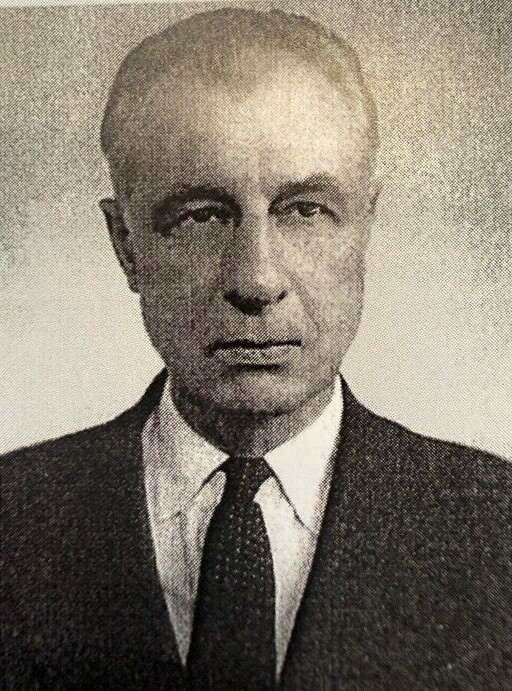 Aleksandr Sokolov
Aleksandr Sokolov Every day for almost 70 years, thousands of people pass between the main building of SPbGASU and the Technological Institute metro station. It was a time, among them was the architect, dean of the Faculty of Urban Planning LISI (now SPbGASU), the author of the project for this station (co-authored with A.K. Andreev) Aleksandr Mikhailovich Sokolov (1906-1984). It was largely thanks to him that the cultural heritage of Leningrad was preserved during the Great Patriotic War.
Study and work
Aleksandr Sokolov entered the preparatory course of the Institute of Civil Engineers (IGI, now SPbGASU) in 1920 after graduating from the Tikhvin Real School, where, according to historical sources, "training was thorough, especially in mathematics and physics," and the Tikhvin Second Soviet Labor School of the 2nd level, where he studied art history as one of the main subjects. In Petrograd, he worked as an assembler, then as a draftsman. At the same time, he began studying in the workshop of Professor I. A. Fomin at the Free Art School of the People's Commissariat of Education of the RSFSR (Academy of Arts). Until 1923, he studied at two universities, and then gave preference to the Academy of Arts. He would return to LISI years later as a teacher.
The architect's famous projects
Aleksandr Sokolov was forced to combine his studies with work. He worked as a foreman (leader of a group of workers) in the Leningrad Commercial Port Administration, as a draftsman at the construction of the I. I. Mechnikov Hospital, and as an assistant to the architect S. O. Ovsyannikov during the construction of the Krasnoye Znamya factory. As a student, he designed an administrative building that was built in 1923–1924 on the territory of the commercial port (it has not survived).
Later, the architect’s famous works included projects for the Vyborg District Sound Cinema with 1,300 seats in Leningrad, the House of the Government of Abkhazia, the building of the All-Union Institute of Experimental Medicine in Moscow, ground pavilions of the Lenin Library metro stations in Moscow and Moskovskie Vorota in Leningrad, and a hotel for sailors in Murmansk.
In the besieged Leningrad and after the war
In 1941, Aleksandr Mikhailovich Sokolov was engaged in research work in the archives of the Pavlovsk Palace Museum. With the outbreak of the war, he took an active part in the evacuation of valuables from the palace and the shelter of the park sculptures. During the siege, he worked in the Inspectorate for the Protection of Monuments, where he took part in the work of the city commission to identify the damage caused to the architectural heritage of Leningrad. The sketches of facades and interiors and design works he made during this period played a major role in the revival of the city. In particular, Aleksandr Sokolov supervised the restoration of the Mariinsky Theater. In 1943, Sokolov was awarded the medal "For the Defense of Leningrad", in 1946 - the medal "For Valiant Labor in the Great Patriotic War of 1941-1945".
In early 1944, the primary task was to develop master plans for the affected cities of the Leningrad, Novgorod and Pskov regions. This work was carried out by the workshop of the Leningrad Regional Department of Architecture and the Lenproekt and Lenoblproekt trusts. The architectural planning workshop of the latter was headed by Aleksandr Sokolov in 1944–1948. Among other things, he worked on the master plan for his native Tikhvin, every corner of which he had known since childhood.
Lecturer, Dean, Professor at LISI
In 1931, Aleksander Mikhailovich Sokolov began teaching architectural design at the Faculty of Architecture of the Leningrad Institute of Municipal Construction (now SPbGASU). In 1943–1946, he headed the course “Introduction to Architecture”. In 1946, he defended his PhD dissertation on “Architectural Structures of Pavlovsk Park”. In 1962–1969, he held the position of Dean of the Faculty of Urban Planning. Then, until 1983, he was a professor at the Department of History and Theory of Architecture.
Other materials of the "Scientific Regiment" project
Our Graduate Built the Road of Life
Front Line of the Architect Aleksandr Nikolsky
Researcher who Developed Science in Besieged Leningrad
Fights of Student Klinov
Engineer of the 3rd Belorussian Front
Nineteen-Year-Old Gunner Stormed Berlin
Path of a Volunteer: from Front-Line Roads to Space Development
Ivan Solomakhin: "The Most Memorable Battle was for this Devil's Hill!"
Fiery Dnieper of the Hero of the Soviet Union Aleksandr Prygunov
Approaching to the Victory
Fedor Komal's Front: from the War Start to the Victory
Junior Political Instructor Boris Gubanov: “Shells Were Whizzing, and the Ground Took off Nearby”
Viktor Kvyatkovsky, Radio Reconnaissance Operator of the Baltic Fleet
How the Chief Architect Nikolai Baranov Kept Leningrad "Hidden" from the Enemy
Architect Nikolai Khomutetsky: Four Years at the Forefront
Semyon Shifrin Thwarted Nazi Plans to Leave Leningrad Waterless
LISI in the Post-War Years
LISI Graduate Mikhail Zherbin, Design Engineer and Composer
Abdulla Mangushev: Four Years at the Front and the Whole Life in Science
Architects Zazerskys Built and Defended the City on the Neva River
Worked His Way Up From a Lieutenant Technician to the Galaxy of Mathematicians
Konstantin Sakhnovsky: From Cadet Of the Russian Empire to Academician of the USSR
Military Architect Of The Front Line Defense And Engineering Intelligence
World-famous scientist, outstanding engineer and national champion
An Outstanding Urban Planner Who Lived And Worked In Besieged Leningrad
Projects by Architect Sergey Evdokimov: from Defensive Structures and City Restoration to Metro Stations
Volunteer Mikhail Laletin: “After the front – to the university, and then, perhaps, to become an officer”